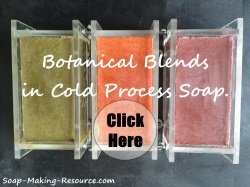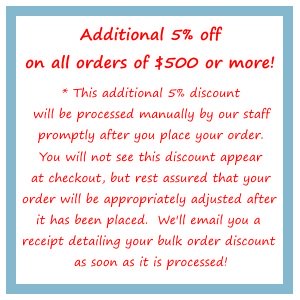Soap Making Instructions
Tea Tree Oil Soap Recipe
Today I am going to be providing you with detailed step by step soap making instructions for a premium tea tree oil soap recipe. The final product is a great skin care soap with lots of lather and conditioning properties. The inclusion of Soap Making Resource's therapeutic grade tea tree essential oil definitely makes this a winner with friends, family and customers!
In this bar, I also add oatmeal which offers a natural scrub feel that is perfect for exfoliating dead skin cells. I hope you enjoy this tutorial for one of my favorite soap recipes! Please let me know if you have any questions about these soap making instructions by contacting me using this form. I'm more then happy to help!
Soap Making Supplies needed...
For this tea tree oil soap recipe, you will need:
- Olive oil (29.15 ounces)
- Palm Kernel oil (9.5 ounces)
- Coconut oil (6.3 ounces)
- Castor oil (3.7 ounces)
- Shea butter (4.3 ounces)
- Almond milk (8.5 ounces)
- Oatmeal (4 tablespoons)
- Silk
- Eucalyptus Globulus Essential Oil (25 grams)
- Lavender 40/42 Essential Oil (25 grams)
- Tea tree Essential Oil (12.5 grams)
- Anise, Star Essential Oil (12.5 grams)
- Lye (210 grams)
- Distilled Water (13.5 ounces)
Ingredients are available right here at soap-making-resource.com... So, be sure to check out the selection!
Get the Kit! (Out of Stock)
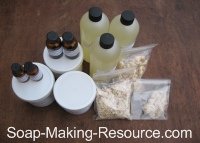
The tea tree oil soap recipe is now available as a full soap making kit. The kit will include full written soap making instructions and more than enough ingredients needed to make the batch. The only ingredients not included are distilled water (which you can pick up at most grocery stores) and lye. Although you can find lye locally in many states, I also include within the kit contact information for my personal lye source! This information alone is truly a wonderful value.
The kit will include 32 ounces of olive oil, 13.5 ounces of palm kernel oil, 13.5 ounces of coconut oil, 16 ounces of castor oil, 13.5 ounces of shea butter, 1 cup blanched almonds, 4 tablespoons whole oats, a small bag of tussah noil soap making silk, 1 ounce of eucalyptus (Globulus) essential oil, 1 ounce of lavender 40/42 essential oil, 1/2 ounce of tea tree essential oil and 1/2 ounce of anise star essential oil.
If you don't already have a soap making mold, be sure to pick up one of the Soap Making Resource 5 pound wooden soap molds or Soap Making Resource 5 pound acrylic soap molds.
Tea Tree Oil Soap Recipe Kit: $65.94 Out of Stock
Directly below, you will find the video version of this tea tree oil soap recipe. Further down the page, I have the soap making instructions written out in detailed form with pictures for each step. You may want to go over both versions of soap making instructions before you make this tea tree oil soap recipe for yourself.
The Recipe Step by Step...
Without further ado, here's the step by step soap making instructions for creating this wonderful tea tree oil soap recipe. Enjoy!
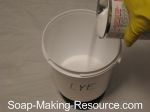
Why are we using grams? Well, it is imperative that you measure the amount of lye in your recipe accurately. Measuring in grams is a lot more precise then measuring in ounces because it is a smaller unit of measurement. You'll notice throughout the various soap making instructions published on my website that I always will use grams for measuring out lye. I recommend you do the same.
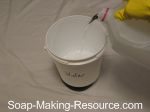
When I refer to ounces within these soap making instructions, even for your water measurement, I am talking about weight ounces. I recommend that you always measure in weight, not volume. Again, it is more accurate!
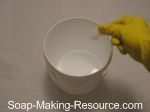
Keep in mind that you really shouldn't use just any silk here. It should be natural silk with no processing or additives. I use cruelty free tussah noil silk fibers in my soap. The silk used as clothing material, in my experience, has a difficult time dissolving compared to tussah noil silk fiber. Silk will add, for lack of a better word, silkiness to your soap's texture when you lather up! It's very nice indeed.
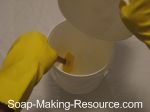
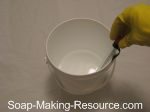
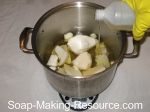
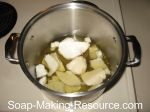
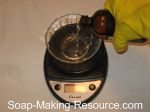
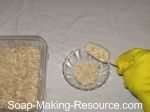
You can add these oats to your soap whole which will offer more of a scrub feel, or you can grind them up in a coffee grinder. I usually choose to grind them up because I personally like that feel better, but it's up to you!
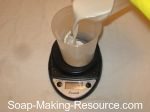
For this size batch, you will need a total of 8.5 ounces of almond milk. Remember in "step 2" of these soap making instructions how I didn't use as much water as I normally would use? I used about 13.5 ounces instead of the typical 20 ounces. Well, this is where we make up for that water discount. Within the total 8.5 ounces of almond milk that we will be incorporating, 6.5 of those ounces is making up for the lack of water and the remaining 2 ounces is extra which will add even more creaminess to the bar. I discounted the water in the beginning because you really don't want too much liquid in your soap. Too much liquid can create a very soft bar that takes a long time to cure.
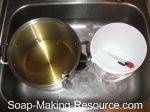
If you are a beginner I recommend following these soap making instructions precisely. Stick with the 100 degrees Fahrenheit temperature. If, however, you have a few batches under your belt, you may have developed your own preferred temperature for making soap. If this is the case, feel free to make the change to your desired temperature.
To cool your oils mixture or lye solution, place the vessels in a sink filled with ice water. Make sure you have a thermometer in both solutions so that you know when the proper temperature is reached! If you need to heat up the oils, you can simply do this on your cooktop. If you need to heat up your lye solution, you can fill your sink with hot water. The temperatures don't need to be 100 degrees on the dot for this tea tree oil soap recipe to work. Just get it close.
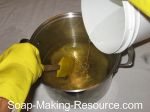
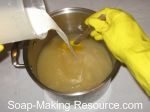
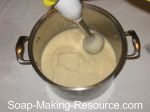
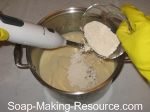
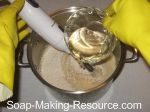
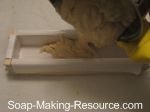
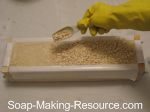
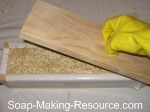
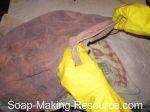
Step 21: After 24 hours your soap should have solidified. Carefully remove the log from the mold. With the Soap Making Resource wooden soap mold this is easily done as both ends of the mold are detachable. Click here to check out the original Soap Making Resource wooden soap mold now!
Step 22: Cut your soap log into standard bars. If you are using one of the Soap Making Resource molds, you can use the built in cutting slot to ensure that all bars are uniform and even. It really makes successfully cutting your bars much easier; doesn't it!
Step 23: The very last step in these soap making instructions is to place your cut bars on a rack to further cure. You should let them cure for about 4 - 6 weeks. This long cure time allows the excess water to evaporate from the bar making your product harder and longer lasting. The combination of oils in this tea tree oil soap recipe will produce a very hard bar. Your soap will also become milder over time.
Thank you very much for reading these step by step soap making instructions for my tea tree oil soap recipe. I hope you enjoyed the tutorial! If you have any questions or feedback, please feel free to contact me via the contact form. I'm happy to help! Stay tuned for more soap making instructions to come very shortly.
Please take a few minutes to sign up for the Soap Making Resource newsletter now and be the first to know when new tutorials are added. I put a lot of hard work into producing each newsletter edition and I think you will really enjoy it!
Have fun browsing the fabulous soap making products available right here at soap-making-resource.com.
Return from soap making instructions - tea tree oil soap recipe to the soap recipes hub page. Return from soap making instructions - tea tree oil soap recipe to the Soap Making Resource Home page.

